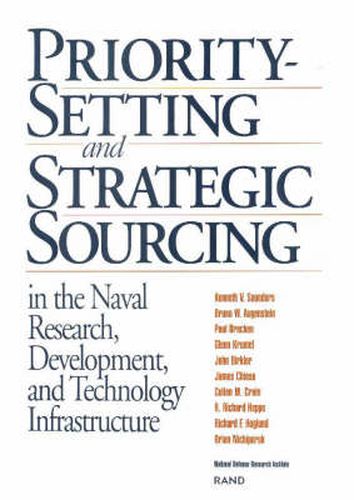Readings Newsletter
Become a Readings Member to make your shopping experience even easier.
Sign in or sign up for free!
You’re not far away from qualifying for FREE standard shipping within Australia
You’ve qualified for FREE standard shipping within Australia
The cart is loading…






This report suggests ways in which the Dept. of the Navy might realize more value from its increasingly constrained research, development, and technology (RD&T) dollars. The study was motivated by the Navy’s immediate policy needs in connection with the 1995 round of Base Realignment and Closure (BRAC) and its longer-term need to make the best use of its resources. Suggestions are presented in three parts. First, the authors develop and apply a framework for setting funding priorities in the Naval RD&T infrastructure. Second, the authors discuss alternative RD&T procurement arrangements that are seeing increasing use in the private sector and that have been used in various parts of the government. These are commonly called smart buying, but the authors use the term strategic sourcing. Third, the authors present a speculative combination of the priority-setting and strategic-sourcing considerations of the first two parts. Using a reinterpretation of the orthogonal plot developed earlier in the report, it suggests a way to help determine which parts of the Naval RD&T infrastructure are best suited for alternative procurement arrangements. It also suggests a way to determine which facilities might be involved.
$9.00 standard shipping within Australia
FREE standard shipping within Australia for orders over $100.00
Express & International shipping calculated at checkout
This report suggests ways in which the Dept. of the Navy might realize more value from its increasingly constrained research, development, and technology (RD&T) dollars. The study was motivated by the Navy’s immediate policy needs in connection with the 1995 round of Base Realignment and Closure (BRAC) and its longer-term need to make the best use of its resources. Suggestions are presented in three parts. First, the authors develop and apply a framework for setting funding priorities in the Naval RD&T infrastructure. Second, the authors discuss alternative RD&T procurement arrangements that are seeing increasing use in the private sector and that have been used in various parts of the government. These are commonly called smart buying, but the authors use the term strategic sourcing. Third, the authors present a speculative combination of the priority-setting and strategic-sourcing considerations of the first two parts. Using a reinterpretation of the orthogonal plot developed earlier in the report, it suggests a way to help determine which parts of the Naval RD&T infrastructure are best suited for alternative procurement arrangements. It also suggests a way to determine which facilities might be involved.